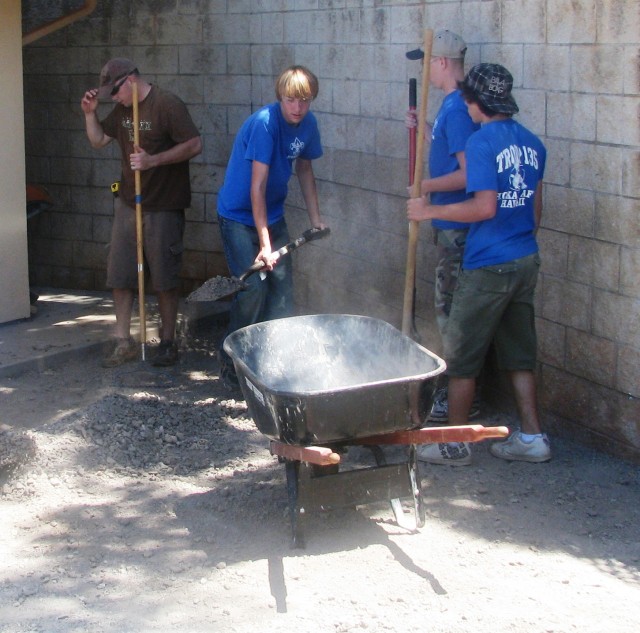HONOLULU (June 13, 2010) -- The Fisher House at Tripler Army Medical Center plays a vital role in the healing of sick or injured service members and their families. The house functions as a 'home away from home' for family members of patients receiving medical care at major military and Veterans Affairs medical centers, allowing families to focus on caring for their loved ones.
When Conner Dooley, Hickam Boy Scout Troop 135, heard the Tripler Fisher House wanted two concrete patios installed near the facility, he didn't hesitate and chose it as his Eagle Scout project.
"I was going to help improve the Aiea loop hiking trail but decided to take on the Fisher House project because it would benefit more people," he said.
Earning the rank of Eagle Scout, the highest rank in Boy Scouting, takes years of work. Scouts must progress through five ranks, earn 21 merit badges, serve six months in a troop leadership position and plan, develop, and give leadership to a service project. The Fisher House project was a challenge for Conner in many ways, according to his mother, Sabina.
"This project took months of planning, coordination, and patience," she said. "It was great to watch Conner's confidence grow throughout this process."
Conner began by doing a cost estimate on the project and figured he could complete the concrete patios for $1860. He sent out a letter to friends and family, asking for donations, and received nearly $2-thousand. He also asked local veterans organizations for financial assistance.
"I took him to the local Veterans of Foreign Wars post and the local American Legion," said Command Sgt. Maj. Scott Dooley, 728th Military Police Battalion, and Conner's father. "He had to pitch his project to them and ask for their support. He received $350 from the American Legion and $500 from the VFW."
After putting the money in the bank, the real work began. He called a local concrete company, Ameron Hawaii, who performed a site survey at the Fisher House. Theresa Johnson, Fisher House Manager, gave the contractor a tour of the facility and the man was so moved by what the Fisher House does for service members and their families, he decided to donate all the concrete needed for the project.
"That was huge," said Conner. "That donation alone saved us almost two thousand dollars and allowed us to spend the money in other ways to help out the Fisher House."
Conner, along with his fellow scouts and volunteers did a lot of preparation work on June 11, clearing out rock in order to level the ground, and setting the expansion joints to hold the concrete in place. The contractor poured the first batch of concrete at 8 a.m. on June 12, and Conner had subject matter experts from the 130th Engineer Brigade on hand to assist with the concrete finishing. As the concrete was drying, Conner, his father, the engineers, and the Fisher House placed coins into the cement as a lasting reminder to those who will enjoy the patios.
Conner and his volunteers completed the project the afternoon of June 12, Conner's 15th birthday, and two days before the Army's 235th birthday. He said he considered it a great present for him, and an early present for Soldiers and their families.
"My hope is that these patios will give the residents of the Fisher House a sense of normalcy, and take their minds off of their problems for a little while," Conner said.
Theresa Johnson, manager of the Tripler Fisher House, said that Connor's project would pay dividends and serve military families for years to come.
"The patios are another stage for the families to enjoy the beautiful weather of Hawaii," she said. "The project was a lot of fun and got the Fisher House residents involved. It also saved us a lot of money. Conner's fundraising efforts will allow us to buy barbeques and furniture for the patios."
Conner also held two food drives, one at the Hickam Commissary and one at the Aliamanu Military Reservation Chapel, in order to fill the food pantry at the Fisher House. He received enough food donations to fill the back of his father's pickup truck.
"This project placed Conner in a leadership position and taught him lessons about planning, coordinating, and managing his fellow scouts and a large group of volunteers," Scott said. "We figured that Conner's efforts saved the Fisher House around nine thousand dollars. When the project was completed, it went about as close to the plan as possible."
"I'm not done yet," Conner said. "I still have my Eagle Scout board of review and have to present my project, but this was a major milestone. Eagle is the pinnacle. I learned a lot about leadership, and that nothing ever goes according to plan. These are skills I can use in the future."
There are 45 Fisher Houses located on 18 military installations and near 15 VA medical centers, and 12 more are in design or under construction. Since philanthropist Zachary Fisher and his wife Elizabeth opened their first house in 1990, more than 120-thousand families have saved more than $100-million in lodging and transportation costs, according to their website.






Social Sharing